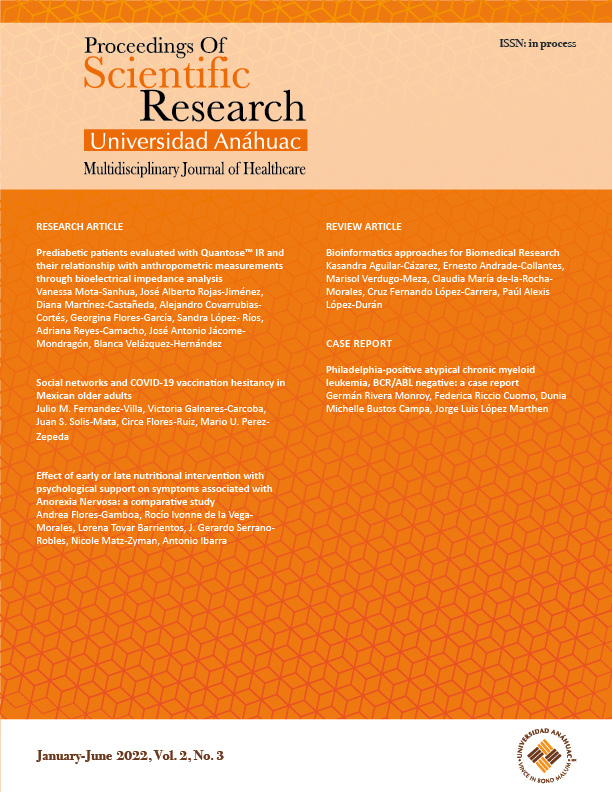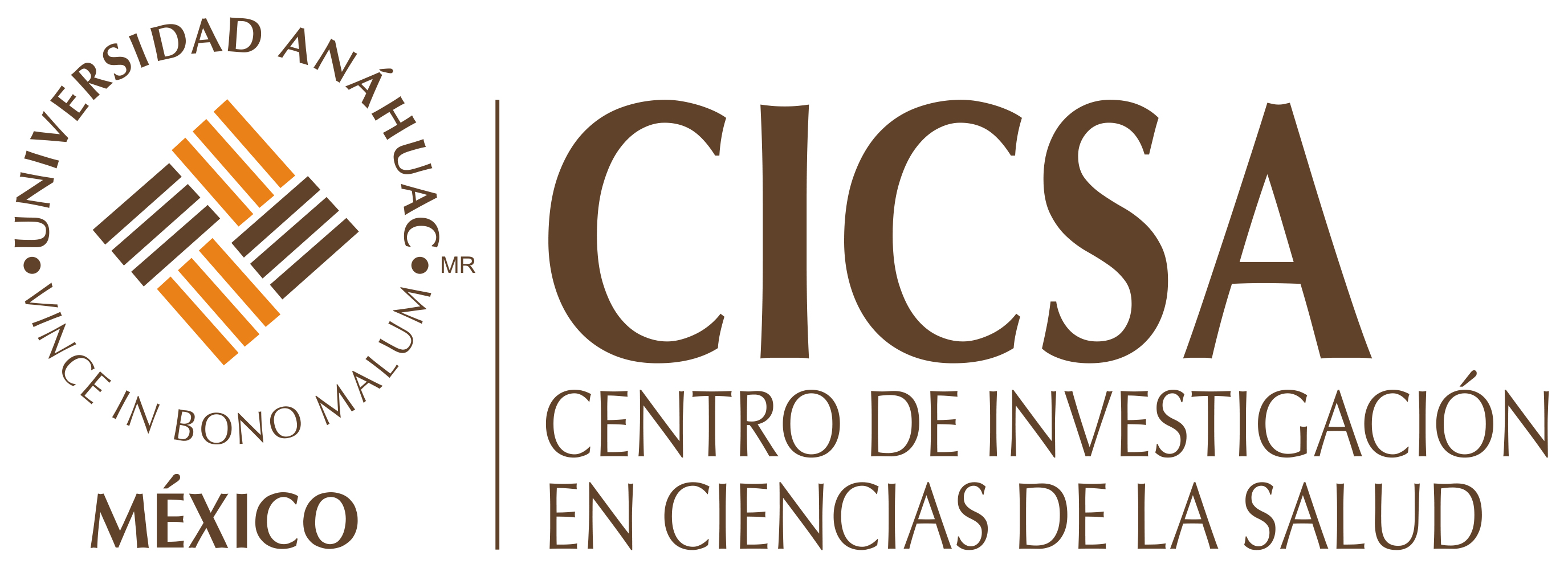Prediabetic patients evaluated with Quantose™ IR and their relationship with anthropometric measurements through bioelectrical impedance analysis
DOI:
https://doi.org/10.36105/psrua.2022v2n3.01Palabras clave:
prediabetes, Quantose-RI, bioimpedancia eléctrica, masa grasa, índice de masa grasa, imcResumen
Introduction: New metabolomic biomarkers as Quantose™ IR and anthropometric measurements using bioelectrical impedance analysis (BIA) provide relevant information on patients with insulin resistance and prediabetes. QuantoseTM IR is a novel metabolomic test to assess insulin resistance for screening and monitoring. Establishing a correlation between these variables is useful in clinical practice and, to our knowledge, there are no published studies that explore the relationship between Quantose™ IR and anthropometric measurements using BIA in patients with prediabetes. Objective: To evaluate the correlation between Quantose™ IR and BIA anthropometric variables (fat mass, FM; fat mass index, FMI; and body mass index, BMI) in Mexican patients with prediabetes, overweight, and obesity. Materials and Methods: This is an observational, transversal analytic study in 135 patients of both genders between 20 and 65 years of age, BMI 25.0–34.9, with diagnosis of prediabetes. The Quantose™ IR test was performed as well as anthropometric measurements (FM, FMI, and BMI) using BIA taken with Inbody 230TM. Pearson’s correlations and independent sample t-tests were estimated with a significance level of p < 0.05. Results: 135 patients were studied; 77% were female, aged 46 years in average. The prevalence of insulin resistance by Quantose™ IR was 71.1%. A positive correlation was confirmed between Quantose™ IR and FM, FMI, and BMI (p < 0.05). Patients with altered Quantose™ IR had higher FM, FMI, and BMI (p < 0.05). Conclusion: The data here presented confirm the existence of a positive and statistically significant correlation between Quantose™ IR and anthropometric measurements using BIA. This information may be useful for diagnosis and treatment in prediabetic, overweight, and obese patients.
Descargas
Referencias
Atlas D. Federación Internacional de Diabetes (FID), 7a. Diabetes: una emergencia mundial. 2015:15. Available from: https://www.fundaciondiabetes.org/general/material/95/avance-nuevo-atlas-de-la-diabetes-de-la-fid-7-edicion--actualizacion-de-2015
Rosas SJ, Caballero AE, Brito CG, García BH, Costa GJ, Lyra R, Rosas GJ. Consenso de prediabetes. Documento de posición de la Asociación Latinoamericana de Diabetes (ALAD). Revista de la ALAD. Asociación Latinoamericana de Diabetes. 2017;7(4):184-202. Available from: doi: 10.24875/ALAD.17000307
Guerrero RF, Rodríguez MM, Pérez FR, Sánchez GMC, González OM, Martínez AE, et al. Prediabetes and its relationship with obesity in Mexican adults: the Mexican Diabetes Prevention (MexDiab) Study. Metab Syndr Relat Disord. 2008 Mar 1;6(1):15-23. Available from: doi: 10.1089/met.2007.0020.
Idle JR, Gonzalez FJ. Metabolomics. Cell metab. 2007 Nov 7;6(5):348-51. Available from: https://doi.org/10.1016/j.cmet.2007.10.005
Cobb J, Gall W, Adam KP, Nakhle P, Button E, Hathorn J, et al. A novel fasting blood test for insulin resistance and prediabetes. J Diabetes Sci Technol. 2013 Jan;7(1):100-10. Available from: https://doi.org/10.1177/193229681300700112
Diaz G. Resistencia a la insulina evaluada por el índice quantose-IR en pacientes con lupus eritematoso sistémico con y sin síndrome metabólico (Master's thesis). Available from: https://hdl.handle.net/20.500.12371/7328
Kelly TL, Wilson KE, Heymsfield SB. Dual energy X-Ray absorptiometry body composition reference values from NHANES. PloS one. 2009 Sep 15;4(9):e7038. Available from: https://doi.org/10.1371/journal.pone.0007038
Vatcheva K, Fisher HS, Reininger B, McCormick J. Sex and age differences in prevalence and risk factors for prediabetes in Mexican-Americans. Diabetes Res Clin Pract. 2020;159:107950. Available from: DOI: 10.1016/j.diabres.2019.107950
Hernández BME, Rojas JJA, Romero GR, et al. Análisis del tejido adiposo visceral por bioimpedancia en pacientes con sobrepeso y su relación con otros índices de resistencia a la insulina. An Med Asoc Med Hosp ABC. 2009;54(4):193-196.
Classification and Diagnosis of Diabetes: Standards of Medical Care in Diabetes—2021. Diabetes Care. 2020;44(Supplement 1):S15-S33. Available from: https://doi.org/10.2337/dc21-S002
Sussulini A. Metabolomics: From Fundamentals to Clinical Applications. Switzerland: Ed. Springer; 2017.
International Society for the Advancement of Kinanthropometry. International standards for the anthropometric assessment of ISAK. 1st ed. South Africa: National Library of Australia. 2001. Available from: https://pdfcoffee.com/isak-book-2-pdf-free.html
Aragon AA, Schoenfeld BJ, Wildman R, Kleiner S, VanDusseldorp T, Taylor L, et al. International society of sports nutrition position stand: diets and body composition. J Int Soc Sports Nutr. 2017 Dec;14(1):1-9. Available from: https://doi.org/10.1186/s12970-017-0174-y
Fernández AS, Navarro KH, editors. El ABCD de la evaluación del estado de nutrición. McGraw-Hill; 2010.
World Health Organization. BMI. [Internet]. 2021 [updated 2021; referenced on September 15, 2021]. Available from: https://www.euro.who.int/en/health-topics/disease-prevention/nutrition/a-healthy-lifestyle/body-mass-index-bmi
San Mauro I, López S, Garicano E, García B, Blumenfeld JA. Detección de la alteración del metabolismo glucídico y resistencia a la insulina en una muestra piloto infantil: Aproximación metabolómica. Universidad y Salud. 2019 Dec; 21(3):191-7. Available from: https://doi.org/10.22267/rus.192103.155
Tripathy D, Cobb J, Gall W, Adam K, George T, Schwenke D et al. A Novel Insulin Resistance Index to Monitor Changes in Insulin Sensitivity and Glucose Tolerance: the ACT NOW Study. The Journal of Clinical Endocrinology & Metabolism. 2015;100(5):1855-62. Available from: https://doi.org/10.1210/jc.2014-3824
Taylor R. Type 2 diabetes remission: latest evidence for health care professionals. Practical Diabetes. 2020;37(5):177-82. Available from: https://doi.org/10.1002/pdi.2297

Descargas
Publicado
Número
Sección
Licencia
Derechos de autor 2022 Vanessa Mota-Sanhuaa, José Alberto Rojas Jiménez, Diana Martínez Castañeda, Alejandro Covarrubias-Cortés, Georgina Flores García, Sandra López Ríos, Adriana Reyes Camacho, José Antonio Jácome-Mondragón, Blanca Velázquez Hernández

Esta obra está bajo una licencia internacional Creative Commons Atribución-NoComercial-SinDerivadas 4.0.
Todo el contenido intelectual que se encuentra en la presente publicación periódica se licencia al público consumidor bajo la figura de Creative Commons©, salvo que el autor de dicho contenido hubiere pactado en contrario o limitado dicha facultad a “Proceedings of Scientific Research Universidad Anáhuac. Multidisciplinary Journal of Healthcare©” o “Universidad Anáhuac México©” por escrito y expresamente.
Proceedings of Scientific Research Universidad Anáhuac. Multidisciplinary Journal of Healthcare se distribuye bajo una Licencia Creative Commons Reconocimiento-No comercial-Sin derivados 4.0 Internacional (CC BY-NC-ND 4.0).
El autor conserva los derechos patrimoniales sin restricciones y garantiza a la revista el derecho de ser la primera publicación del trabajo. El autor es libre de publicar en cualquier otro medio su artículo, como un repositorio institucional.














